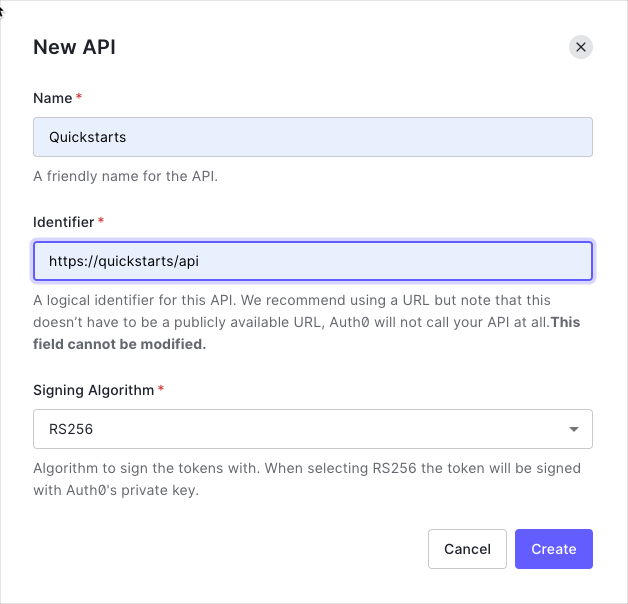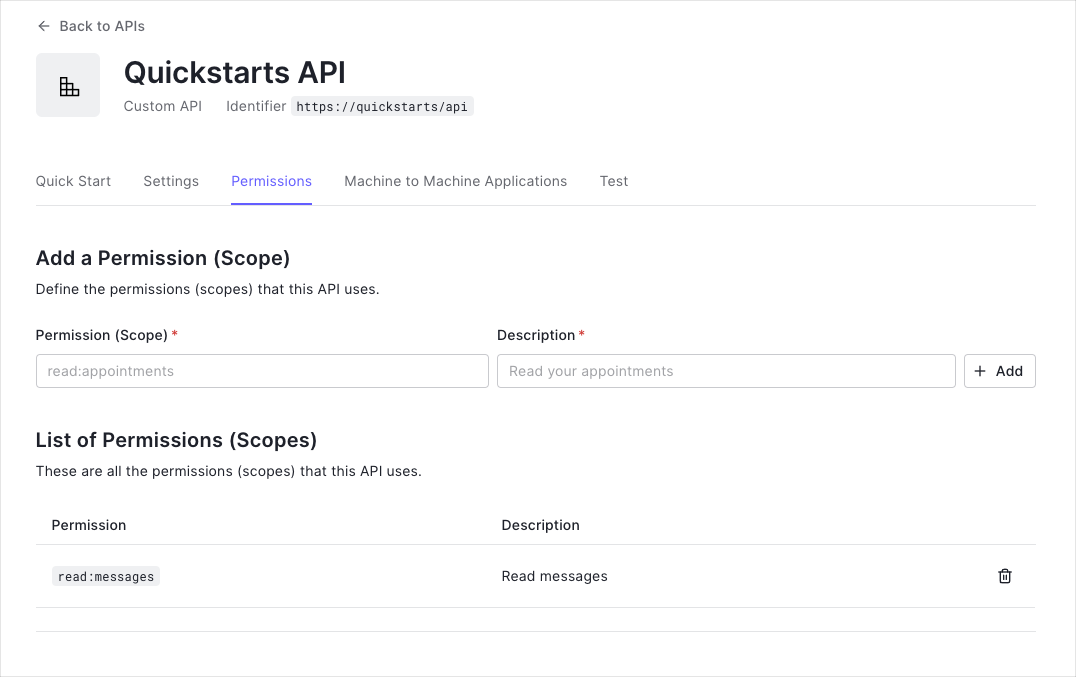Django API: Authorization
This tutorial demonstrates how to add authorization to a Django REST Framework API. We recommend that you log in to follow this quickstart with examples configured for your account.
I want to integrate with my app
15 minutesI want to explore a sample app
2 minutesGet a sample configured with your account settings or check it out on Github.
Configure Auth0 APIs
Create an API
In the APIs section of the Auth0 dashboard, click Create API. Provide a name and an identifier for your API, for example, https://quickstarts/api. You will use the identifier as an audience later, when you are configuring the Access Token verification. Leave the Signing Algorithm as RS256.

By default, your API uses RS256 as the algorithm for signing tokens. Since RS256 uses a private/public keypair, it verifies the tokens against the public key for your Auth0 account. The public key is in the JSON Web Key Set (JWKS) format, and can be accessed here.
Define permissions
Permissions let you define how resources can be accessed on behalf of the user with a given access token. For example, you might choose to grant read access to the messages resource if users have the manager access level, and a write access to that resource if they have the administrator access level.
You can define allowed permissions in the Permissions view of the Auth0 Dashboard's APIs section.

This example demonstrates:
-
How to check for a JSON Web Token (JWT) in the
Authorizationheader of an incoming HTTP request. -
How to check if the token is valid, using the JSON Web Key Set (JWKS) for your Auth0 account. To learn more about validating Access Tokens, see Validate Access Tokens.
Setup the Django Application
Install dependencies
Add the following dependencies to your requirements.txt and run pip install -r requirements.txt.
cryptography~=2.8
django~=2.2.7
djangorestframework~=3.10.31
django-cors-headers~=3.1.1
drf-jwt~=1.13.3
pyjwt~=1.7.1
requests~=2.22.0Was this helpful?
Create a Django project
This guide assumes you already have a Django application set up. If that is not the case, follow the steps in the Django Tutorial.
The sample project was created with the following commands:
django-admin startproject apiexample
cd apiexample
python manage.py startapp auth0authorizationWas this helpful?
Add a Django remote user
You need to define a way to map the username from the Access Token payload to the Django authentication system user.
Add RemoteUserMiddleware middleware component after AuthenticationMiddleware to middleware list.
# apiexample/settings.py
MIDDLEWARE = [
# ...
'django.contrib.auth.middleware.AuthenticationMiddleware',
'django.contrib.auth.middleware.RemoteUserMiddleware',
]Was this helpful?
Add ModelBackend and RemoteUserBackend to the Authentication Backends.
# apiexample/settings.py
AUTHENTICATION_BACKENDS = [
'django.contrib.auth.backends.ModelBackend',
'django.contrib.auth.backends.RemoteUserBackend',
]Was this helpful?
Create utils.py file in your application's folder and define a function that maps the sub field from the access_token to the username. Then, the authenticate method from RemoteUserBackend will create a remote user in the Django authentication system and return a User object for the username.
# auth0authorization/utils.py
from django.contrib.auth import authenticate
def jwt_get_username_from_payload_handler(payload):
username = payload.get('sub').replace('|', '.')
authenticate(remote_user=username)
return usernameWas this helpful?
Validate Access Tokens
The settings.py file contains the configuration of the Django project.
Add rest_framework app to the INSTALLED_APPS entry.
# apiexample/settings.py
INSTALLED_APPS = [
# ...
'rest_framework'
]Was this helpful?
Add JSONWebTokenAuthentication to Django REST framework's DEFAULT_AUTHENTICATION_CLASSES.
# apiexample/settings.py
REST_FRAMEWORK = {
'DEFAULT_PERMISSION_CLASSES': (
'rest_framework.permissions.IsAuthenticated',
),
'DEFAULT_AUTHENTICATION_CLASSES': (
'rest_framework_jwt.authentication.JSONWebTokenAuthentication',
'rest_framework.authentication.SessionAuthentication',
'rest_framework.authentication.BasicAuthentication',
),
}Was this helpful?
Configure the Django REST Framework JWK by setting the JWT_AUTH variable.
Set the JWT_AUDIENCE to your API identifier and the JWT_ISSUER to your Auth0 domain. By default, those values will be retrieved from the .env file.
# apiexample/settings.py
JWT_AUTH = {
'JWT_PAYLOAD_GET_USERNAME_HANDLER':
'auth0authorization.utils.jwt_get_username_from_payload_handler',
'JWT_DECODE_HANDLER':
'auth0authorization.utils.jwt_decode_token',
'JWT_ALGORITHM': 'RS256',
'JWT_AUDIENCE': '{yourApiIdentifier}',
'JWT_ISSUER': 'https://{yourDomain}/',
'JWT_AUTH_HEADER_PREFIX': 'Bearer',
}Was this helpful?
Create the function to fetch the JWKS from your Auth0 account to verify and decode the incoming Access Token.
# auth0authorization/utils.py
import json
import jwt
import requests
def jwt_decode_token(token):
header = jwt.get_unverified_header(token)
jwks = requests.get('https://{}/.well-known/jwks.json'.format('{yourDomain}')).json()
public_key = None
for jwk in jwks['keys']:
if jwk['kid'] == header['kid']:
public_key = jwt.algorithms.RSAAlgorithm.from_jwk(json.dumps(jwk))
if public_key is None:
raise Exception('Public key not found.')
issuer = 'https://{}/'.format('{yourDomain}')
return jwt.decode(token, public_key, audience='{yourApiIdentifier}', issuer=issuer, algorithms=['RS256'])Was this helpful?
Validate scopes
Add the following methods to the views.py file to create a decorator that will check the granted scopes from the access_token.
# auth0authorization/views.py
from functools import wraps
import jwt
from django.http import JsonResponse
def get_token_auth_header(request):
"""Obtains the Access Token from the Authorization Header
"""
auth = request.META.get("HTTP_AUTHORIZATION", None)
parts = auth.split()
token = parts[1]
return token
def requires_scope(required_scope):
"""Determines if the required scope is present in the Access Token
Args:
required_scope (str): The scope required to access the resource
"""
def require_scope(f):
@wraps(f)
def decorated(*args, **kwargs):
token = get_token_auth_header(args[0])
decoded = jwt.decode(token, verify=False)
if decoded.get("scope"):
token_scopes = decoded["scope"].split()
for token_scope in token_scopes:
if token_scope == required_scope:
return f(*args, **kwargs)
response = JsonResponse({'message': 'You don\'t have access to this resource'})
response.status_code = 403
return response
return decorated
return require_scopeWas this helpful?
Protect API Endpoints
The routes shown below are available for the following requests:
GET /api/public: available for non-authenticated requestsGET /api/private: available for authenticated requests containing an access token with no additional scopesGET /api/private-scoped: available for authenticated requests containing an access token with theread:messagesscope granted
In the file views.py add public and private endpoints. Add the @api_view decorator to all the endpoints to indicate that the method requires authentication. Lastly, add the decorator @permission_classes([AllowAny]) to the public endpoint to accept unauthenticated requests.
# auth0authorization/views.py
from django.http import JsonResponse
from rest_framework.decorators import api_view, permission_classes
from rest_framework.permissions import AllowAny
@api_view(['GET'])
@permission_classes([AllowAny])
def public(request):
return JsonResponse({'message': 'Hello from a public endpoint! You don\'t need to be authenticated to see this.'})
@api_view(['GET'])
def private(request):
return JsonResponse({'message': 'Hello from a private endpoint! You need to be authenticated to see this.'})Was this helpful?
Use the requires_scope decorator in the methods that require specific scopes granted. The method below requires the read:messages scope granted.
# auth0authorization/views.py
@api_view(['GET'])
@requires_scope('read:messages')
def private_scoped(request):
return JsonResponse({'message': 'Hello from a private endpoint! You need to be authenticated and have a scope of read:messages to see this.'})Was this helpful?
Add URL mappings
In previous steps, we added methods to the views.py file. We need to map those methods to URLs.
Django has a URL dispatcher that lets you map URL patterns to views.
Create the file urls.py in your application folder. Add the URL patterns.
# auth0authorization/urls.py
from django.urls import path
from . import views
urlpatterns = [
path('api/public', views.public),
path('api/private', views.private),
path('api/private-scoped', views.private_scoped),
]Was this helpful?
The Django project also has a urls.py file. Add a reference to your application's urls.py file.
# apiexample/urls.py
from django.contrib import admin
from django.urls import include, path
urlpatterns = [
path('admin/', admin.site.urls),
path('', include('auth0authorization.urls'))
]Was this helpful?